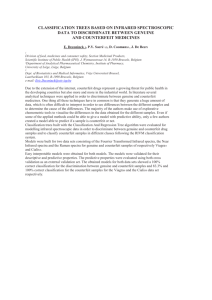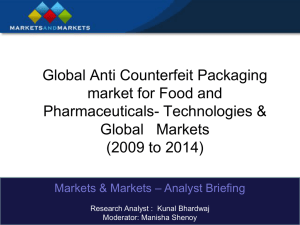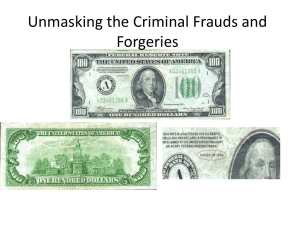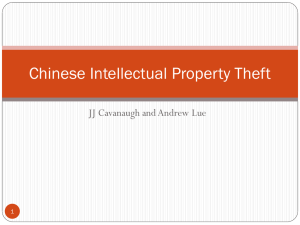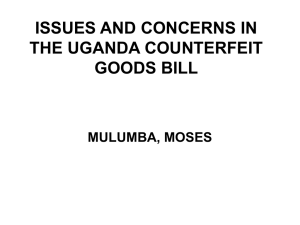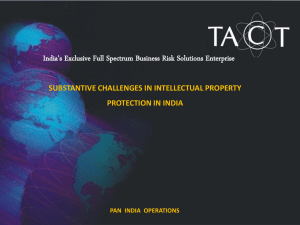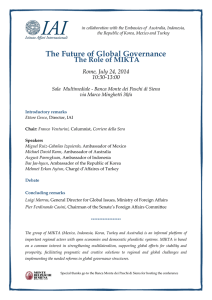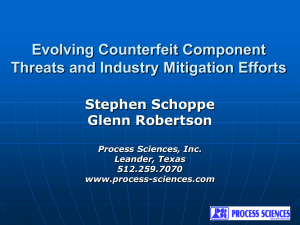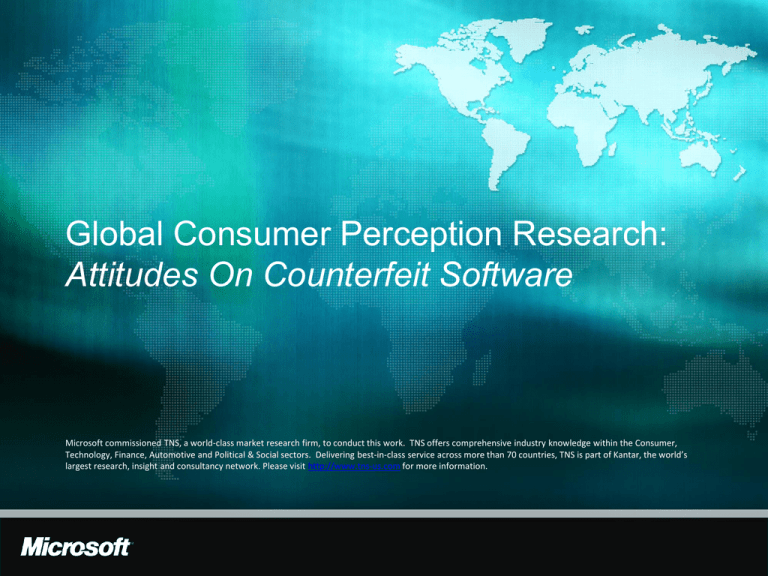
Global Consumer Perception Research:
Attitudes On Counterfeit Software
Microsoft commissioned TNS, a world-class market research firm, to conduct this work. TNS offers comprehensive industry knowledge within the Consumer,
Technology, Finance, Automotive and Political & Social sectors. Delivering best-in-class service across more than 70 countries, TNS is part of Kantar, the world’s
largest research, insight and consultancy network. Please visit http://www.tns-us.com for more information.
Key Finding #1:
Consumers know the difference between genuine and counterfeit
software; and that genuine software performs better
There is a real difference between
counterfeit and genuine software
Compared to counterfeit,
genuine software...
All consumers agree
By a 2:1 margin, consumers agree
that there is a real difference between
counterfeit and genuine software.
For country-specific data, please visit “Table 1” in the Appendix
Is what I want to use
73%
Is more secure
72%
Is more stable
71%
Is easy to keep up to date
73%
For country-specific data, please visit “Table 2” in the Appendix
Key Finding #2:
Consumers 4X more likely to recommend genuine than
counterfeit software
Survey Question: If a friend or relative asked you for your opinion about whether to buy
counterfeit or genuine software, which of the following are you most likely to advise them?
82%
18%
For country-specific data, please visit “Table 3” in the Appendix
Buy the genuine software, even if it costs more
Buy the
counterfeit
software, as long
as they are
getting a good
price and know
the risks involved
Key Finding #3:
Consumers say there are risks with using counterfeit software
Consumers agree counterfeit software
is not as safe to use as genuine
Consumers express a range of
concerns about counterfeit software
DK, 10%
No
concerns,
10%
By a 3:1 margin, consumers
agree that counterfeit software
is not as safe to use as genuine
software.
Lose data, 26%
Other concerns,
15%
Identity theft,
23%
For country-specific data, please visit “Table 4” in the Appendix
Funding crime,
15%
•
•
50% cite either data loss or identity theft
Only 10% say they have no concerns
For country-specific data, please visit “Table 5” in the Appendix
Key Finding #4:
Consumers support action to cut down on counterfeit software
75%
agree
72%
agree
65%
agree
Consumers
Need ways to protect themselves from inadvertently buying counterfeit software
Software companies
Should do more to stop their products from being counterfeited
Government
Should do more to reduce the amount of counterfeit software
For country-specific data, please visit “Table 6” in the Appendix
Key Finding #5:
Consumers tell us they are doing their part – most often by checking
the packaging and entering the product key
Bought
in a store
Checked the software packaging
for evidence that the software
was genuine (e.g., seals, product
key numbers and so on)
Asked the sales person whether
or not the software was genuine
72%
22%
6%
For country-specific data, please visit “Table 7.1” in the Appendix
46%
45%
8%
For country-specific data, please visit “Table 7.1” in the Appendix
Bought
online
Checked the product description
to make sure I was buying
genuine software
72%
19%
9%
For country-specific data, please visit “Table 7.2” in the Appendix
Regardless
of where
bought
Entered the product key that came
with the software to activate it
78%
10%
13%
For country-specific data, please visit “Table 7.3” in the Appendix
I did this
I did not do this
I can't recall
60% of
these
checked
the
packaging
instead
Methodology
•
Online survey fielded in twenty countries from September 22-October 5,
2010.
•
Over 38,000 consumers were polled online.
•
Consumers were all over the age of 18, owned a PC in their homes, and
were the primary decision makers for PC/software purchases.
•
At the start of the survey consumers were given a description of genuine
and counterfeit products:
– A genuine product is one made and sold by a company, either directly
or through stores or the Internet.
– A counterfeit product is one that copies the genuine product and is
sold either by the person who made the copy, or through stores or the
Internet. Sometimes people buying counterfeit products know they are
not genuine and other times they do not.
Appendix
Table 1
Table 2
There is a real difference between
genuine and counterfeit software
Compared to counterfeit, genuine software...
Country
Agree to disagree ratio
Country
Is what I want to
use
Is more secure
Is more stable
Is easy to keep up to
date
Worldwide
2.0 to 1
Worldwide
73%
72%
71%
73%
Argentina
1.4 to 1
Argentina
76%
74%
71%
78%
Australia
4.0 to 1
Australia
71%
66%
65%
67%
Brazil
3.1 to 1
Brazil
79%
77%
73%
78%
Canada
2.2 to 1
Canada
67%
63%
63%
66%
China
2.3 to 1
China
70%
74%
76%
76%
France
2.0 to 1
France
69%
72%
67%
68%
Germany
3.7 to 1
Germany
73%
70%
66%
71%
India
1.7 to 1
India
77%
77%
76%
77%
Indonesia
0.8 to 1
Indonesia
85%
85%
85%
84%
Italy
1.3 to 1
Italy
70%
72%
66%
73%
Japan
4.4 to 1
Japan
71%
72%
67%
59%
Korea
1.1 to 1
Korea
61%
63%
62%
68%
Mexico
1.7 to 1
Mexico
79%
78%
78%
78%
Netherlands
0.7 to 1
Netherlands
69%
62%
60%
69%
Poland
1.5 to 1
Poland
67%
71%
67%
74%
Russia
2.0 to 1
Russia
76%
72%
72%
76%
Spain
1.2 to 1
Spain
61%
66%
62%
69%
Turkey
3.7 to 1
Turkey
90%
90%
89%
90%
United Kingdom
5.0 to 1
United Kingdom
79%
74%
75%
72%
United States
5.9 to 1
United States
79%
73%
73%
72%
Table 3
If a friend or relative asked you for your opinion about
whether to buy counterfeit or genuine software, which
of the following are you most likely to advise them?
Country
Genuine
Counterfeit
Worldwide
82%
18%
Argentina
76%
24%
Australia
86%
14%
Brazil
84%
16%
Canada
81%
19%
China
57%
43%
France
87%
13%
Germany
90%
10%
India
86%
14%
Indonesia
82%
18%
Italy
80%
20%
Japan
95%
5%
Korea
70%
30%
Mexico
85%
15%
Netherlands
79%
21%
Poland
85%
15%
Russia
73%
27%
Spain
75%
25%
Turkey
90%
10%
United Kingdom
90%
10%
United States
92%
8%
Table 4
Consumers agree counterfeit software
is not as safe to use as genuine
Country
Agree to disagree ratio
Worldwide
3.0 to 1
Argentina
1.9 to 1
Australia
4.5 to 1
Brazil
4.4 to 1
Canada
2.6 to 1
China
2.8 to 1
France
2.1 to 1
Germany
6.4 to 1
India
2.2 to 1
Indonesia
2.2 to 1
Italy
1.8 to 1
Japan
8.3 to 1
Korea
2.5 to 1
Mexico
3.5 to 1
Netherlands
2.6 to 1
Poland
2.3 to 1
Russia
1.8 to 1
Spain
2.2 to 1
Turkey
7.5 to 1
United Kingdom
6.3 to 1
United States
6.2 to 1
Table 5
Consumers express a range of concerns about counterfeit software
Country
Data Loss
Identity Theft
Other Concerns
No Concerns
Unaware
Worldwide
26%
23%
30%
10%
10%
Argentina
23%
16%
23%
27%
10%
Australia
21%
33%
26%
8%
11%
Brazil
24%
18%
44%
10%
4%
Canada
20%
25%
29%
11%
15%
China
35%
25%
26%
8%
5%
France
24%
29%
29%
6%
11%
Germany
24%
28%
32%
4%
12%
India
32%
16%
36%
9%
7%
Indonesia
37%
16%
30%
10%
7%
Italy
24%
17%
35%
12%
12%
Japan
24%
29%
23%
4%
20%
Korea
33%
14%
35%
9%
9%
Mexico
28%
19%
40%
9%
4%
Netherlands
18%
20%
19%
21%
22%
Poland
20%
15%
45%
10%
10%
Russia
30%
18%
29%
19%
4%
Spain
37%
17%
20%
17%
9%
Turkey
27%
37%
30%
3%
2%
United Kingdom
22%
36%
27%
7%
9%
United States
23%
38%
19%
9%
12%
Table 6
Consumers support action to cut down on counterfeit software
Country
Consumers needs ways to
protect themselves
Software companies to stop their
products from being counterfeited
Government to do more to reduce
the amount of counterfeit
software
Worldwide
75%
72%
65%
Argentina
77%
73%
62%
Australia
70%
65%
58%
Brazil
78%
80%
78%
Canada
68%
65%
54%
China
72%
74%
73%
France
77%
67%
63%
Germany
75%
65%
54%
India
79%
82%
76%
Indonesia
88%
87%
85%
Italy
70%
68%
61%
Japan
69%
73%
68%
Korea
63%
69%
65%
Mexico
85%
87%
81%
Netherlands
62%
66%
49%
Poland
75%
72%
62%
Russia
78%
73%
65%
Spain
69%
59%
50%
Turkey
85%
85%
85%
United Kingdom
76%
73%
63%
United States
76%
68%
52%
Table 7.1
When you buy software, do you check the software
packaging for evidence that the software was
genuine?
When you buy software, do you ask the retailer
whether or not the software was genuine?
Country
Yes
No
Do not recall
Country
Yes
No
Do not recall
Worldwide
46%
45%
8%
Worldwide
72%
22%
6%
Argentina
57%
32%
12%
Argentina
62%
31%
7%
Australia
25%
63%
12%
Australia
66%
28%
6%
Brazil
59%
34%
7%
Brazil
77%
18%
5%
Canada
26%
66%
8%
Canada
65%
29%
6%
China
77%
19%
5%
China
76%
19%
5%
France
29%
64%
8%
France
68%
27%
5%
Germany
34%
56%
10%
Germany
68%
26%
6%
India
83%
12%
4%
India
80%
16%
5%
Indonesia
73%
22%
4%
Indonesia
81%
15%
3%
Italy
43%
48%
9%
Italy
78%
16%
6%
Japan
21%
69%
10%
Japan
48%
42%
10%
Korea
57%
36%
7%
Korea
67%
29%
4%
Mexico
55%
37%
7%
Mexico
76%
19%
5%
Netherlands
28%
63%
8%
Netherlands
68%
26%
7%
Poland
52%
37%
11%
Poland
82%
12%
6%
Russia
60%
29%
11%
Russia
81%
13%
5%
Spain
32%
60%
7%
Spain
64%
30%
6%
Turkey
54%
37%
8%
Turkey
82%
14%
5%
United Kingdom
19%
69%
13%
United Kingdom
62%
31%
7%
United States
15%
75%
10%
United States
60%
33%
7%
Table 7.2
Table 7.3
Checked the product description to make sure I was buying
genuine software
Country
Yes
No
Do not recall
Worldwide
72%
19%
9%
Argentina
62%
26%
12%
Australia
75%
15%
10%
Brazil
79%
15%
6%
Canada
66%
24%
10%
China
68%
24%
8%
France
69%
22%
9%
Germany
74%
18%
8%
India
87%
8%
5%
Indonesia
87%
11%
3%
Italy
82%
13%
4%
Japan
61%
25%
14%
Korea
63%
26%
12%
Mexico
73%
18%
8%
Netherlands
67%
23%
10%
Poland
75%
18%
8%
Russia
70%
20%
10%
Spain
74%
19%
7%
Turkey
70%
20%
10%
United Kingdom
75%
15%
10%
United States
72%
18%
10%
Entered the product key that came with the software to activate it
Country
Yes
No
Do not recall
Worldwide
78%
10%
13%
Argentina
67%
12%
21%
Australia
81%
9%
11%
Brazil
79%
10%
11%
Canada
78%
11%
11%
China
74%
15%
10%
France
79%
7%
15%
Germany
82%
8%
10%
India
77%
11%
12%
Indonesia
79%
13%
9%
Italy
78%
8%
13%
Japan
62%
19%
20%
Korea
68%
18%
14%
Mexico
78%
8%
14%
Netherlands
78%
6%
16%
Poland
83%
7%
10%
Russia
86%
6%
8%
Spain
80%
8%
12%
Turkey
79%
7%
14%
United Kingdom
78%
8%
14%
United States
77%
9%
14%
© 2010. Microsoft Corporation. All Rights Reserved.

